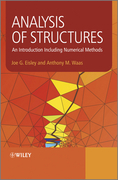
Analysis of structures: an introduction including numerical methods
Eisley, Joe
Waas, Antony
Analysis of Structures offers an original way of introducing engineering students to the subject of stress and deformation analysis of solid objects, and helps them become more familiar with how numerical methods such as the finite element method are used in industry. Eisley and Waas secure for the reader a thorough understanding of the basic numerical skills and insight into interpreting the results these methods can generate. Throughout the text, they include analytical development alongside the computational equivalent, providing the student with the understanding that is necessary to interpret and use the solutions that are obtained using software based on the finite element method. They then extend these methods to the analysis of solid and structural components that are used in modern aerospace, mechanical and civil engineering applications. Analysis of Structures is accompanied by a book companion website www.wiley.com/go/waas housing exercises and examples that use modern software which generates color contour plots of deformation and internal stress.It offers invaluable guidance and understanding to senior level and graduate students studyingcourses in stress and deformation analysis as part of aerospace, mechanical and civil engineering degrees as well as to practicing engineers who want to re-train or re-engineer their set of analysis tools for contemporary stress and deformation analysis of solids and structures. Provides a fresh, practical perspective to the teaching of structural analysis using numerical methods for obtaining answers to real engineering applications Proposes a new way of introducing students to the subject of stress and deformation analysis of solid objects that are used in a wide variety of contemporary engineering applications Casts axial, torsional and bending deformations of thin walled objects in a framework that is closely amenable to the methods by which modern stress analysis software operates. INDICE: About the Authors Series Editor Preface Preface Chapter 1. Forces and Moments 1.1. Introduction1.2. Units 1.3. Forces in Mechanics of Materials 1.4. Concentrated Forces 1.5. Moment of a Concentrated Force 1.6. Distributed Forces. Force and Moment Resultants 1.7. Internal Forces and Stresses. Stress Resultants 1.8. Restraint Forces and Restraint Force Resultants 1.9. Summary and Conclusions Chapter 2. Static Equilibrium 2.1. Introduction 2.2. Free Body Diagrams 2.3. Equilibrium - Concentrated Forces 2.4. Equilibrium - DistributedForces2.5. Equilibrium in Three Dimensions 2.6. Equilibrium - Internal Forcesand Stresses 2.7. Summary and Conclusions Chapter 3. Displacement, Strain, and Material Properties 3.1. Introduction 3.2. Displacement and Strain3.3. Compatibility 3.4. Linear Material Properties 3.5. Some Simple Solutions for Stress, Strain, and Displacement 3.6. Thermal Strain 3.7. Engineering Materials 3.8.Fiber Reinforced Composite Laminates3.9. Plan for the Following Chapters 3.10. Summary and Conclusions Chapter 4. Classical Analysis of the Axially Loaded Slender Bar 4.1. Introduction 4.2. Solutions from the Theory of Elasticity 4.3. Derivation and Solution of the Governing Equations 4.4. The Statically Determinate Case4.5. The Statically Indeterminate Case 4.6. Variable Cross Sections4.7. Thermal Stress and Strain in an Axially Loaded Bar4.8. Shearing Stress in an Axially Loaded Bar 4.9. Design of Axially Loaded Bars4.10. Analysis and Design of Pin Jointed Trusses4.11. Work and Energy. Castigliano's Second Theorem 4.12. Summary and Conclusions Chapter 5. A General Method for the Axially Loaded Slender Bar 5.1 Introduction 5.2. Nodes, Elements, Shape Functions, and the Element Stiffness Matrix5.3. The Assembled Global Equations and Their Solution5.4. A General Method. Distributed Applied Loads 5.5. Variable Cross Sections 5.6. Analysis and Design of Pin-jointed Trusses5.7. Summary and ConclusionsChapter 6. Torsion 6.1. Introduction 6.2. Torsional Displacement, Strain, andStress 6.3. Derivation and Solution of the Governing Equations 6.4. Solutionsfrom the Theory of Elasticity6.5. Torsional Stress in Thin Walled Cross Sections 6.6. Work and Energy. Torsional Stiffness in a Thin Walled Tube 6.7. Torsional Stress and Displacement in Thin Walled Open Sections 6.8. A General (Finite Element) Method 6.9. Continuously Variable Cross Sections6.10. Summary and Conclusions Chapter 7. Classical Analysis of the Bending of Beams 7.1. Introduction7.2. Area Properties. Sign Conventions 7.3. Derivation and Solution of the Governing Equations 7.4. The Statically Determinate Case 7.5. Work and Energy. Castigliano's Theorem 7.6. The Statically Indeterminate Case 7.7. Solutionsfrom the Theory of Elasticity 7.8. Variable Cross Sections7.9. Shear Stress in Non Rectangular Cross Sections. Thin Walled Cross Sections 7.10. Design of Beams 7.11. Large Displacements 7.12. Summary and Conclusions Chapter 8. A General Method (FEM) for the Bending of Beams 8.1
- ISBN: 978-0-470-97762-0
- Editorial: John Wiley & Sons
- Encuadernacion: Cartoné
- Páginas: 608
- Fecha Publicación: 05/08/2011
- Nº Volúmenes: 1
- Idioma: Inglés
